高中语法大全语法复习八:助动词与情态动词
高中语法 助动词和情态动词
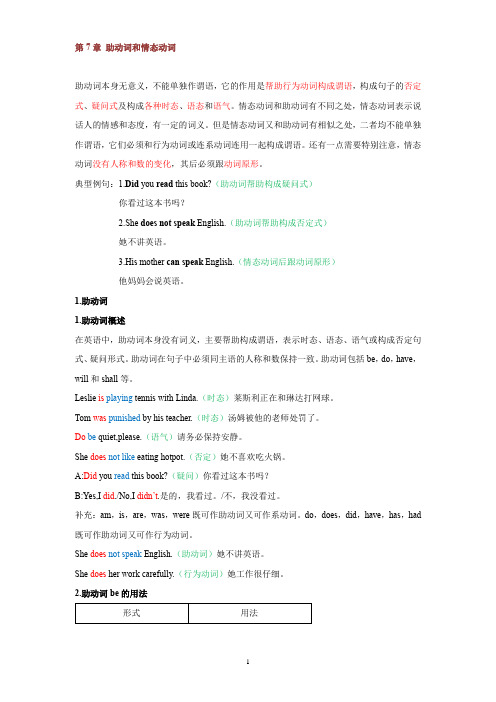
第7章助动词和情态动词助动词本身无意义,不能单独作谓语,它的作用是帮助行为动词构成谓语,构成句子的否定式、疑问式及构成各种时态、语态和语气。
情态动词和助动词有不同之处,情态动词表示说话人的情感和态度,有一定的词义。
但是情态动词又和助动词有相似之处,二者均不能单独作谓语,它们必须和行为动词或连系动词连用一起构成谓语。
还有一点需要特别注意,情态动词没有人称和数的变化,其后必须跟动词原形。
典型例句:1.Did you read this book?(助动词帮助构成疑问式)你看过这本书吗?2.She does not speak English.(助动词帮助构成否定式)她不讲英语。
3.His mother can speak English.(情态动词后跟动词原形)他妈妈会说英语。
1.助动词1.助动词概述在英语中,助动词本身没有词义,主要帮助构成谓语,表示时态、语态、语气或构成否定句式、疑问形式。
助动词在句子中必须同主语的人称和数保持一致。
助动词包括be,do,have,will和shall等。
Leslie is playing tennis with Linda.(时态)莱斯利正在和琳达打网球。
Tom was punished by his teacher.(时态)汤姆被他的老师处罚了。
Do be quiet,please.(语气)请务必保持安静。
She does not like eating hotpot.(否定)她不喜欢吃火锅。
A:Did you read this book?(疑问)你看过这本书吗?B:Yes,I did./No,I didn’t.是的,我看过。
/不,我没看过。
补充:am,is,are,was,were既可作助动词又可作系动词。
do,does,did,have,has,had 既可作助动词又可作行为动词。
She does not speak English.(助动词)她不讲英语。
高考语法-情态动词与助动词

高考语法——情态动词(can, may, must…)与助动词(be, do, have)一、“情态动词+动词完成式”用法1. may (might)+动词完成式:对过去行为的推测E.g. If we had taken the other road, we might have arrived earlier.2. can (could) +动词完成式:1) 表示对过去能做而未做的事,表示惋惜。
E.g. In those circumstances we could have done better.2) 对过去行为的推测E.g. Where can (could) she have gone?注意:can't和couldn't+动词原形:可以表示否定推断。
E.g. He can't be the President.3. must +动词完成式: 对过去行为的推断,具有极大可能性,意为“一定”E.g. He must have undergone an ordeal no one can imagined.注意:“must + 动词原形”表示对现在行为的推测;“must be +现在分词”表示对现在正在进行的或未来的推测。
E.g. She looks happy; she must be having a good time.It must be raining tomorrow according to the weather forecast.4. “needn't + 动词完成式”和“didn't need to do”1) “needn't + 动词完成式”表示一种已经做过的但无必要的行为E.g. You needn't have watered the flowers, for it is going to rain.2) "didn't need to do" 表示没有必要做,实际上也没有做的行为E.g. I didn't need to mop the floor. My mom did it.5. "Should + 动词完成式":肯定结构表示应该做的事而没有做,否定式表示某行为不该发生却发生了。
助动词和情态动词的用法总结

4) 祝愿:May you be happy!
情态动词--明晰每一个情态动词的具体功能
2
2. might 1) 可否, 含义比may委婉。
A. 用于问句:Might I use your phone?
B. 用于陈述句:You might call at the chemist on the way home.
Cars must not park in front of the entrance. We mustn’t be
late.
情态动词--明晰每一个情态动词的具体功能
4
3) 推断。
A. 现在可能: He must know the answer.
B. 过去可能: We must have read the same report.
3
4) 轻微批评、抱怨。
A. 针对现在:You might tell me if you’re going to be late.\
B. 针对过去:You might at least have phoned me if you’re not
coming.
3. must
1) 必须、一定。
A. 指现在或将来:
2) 否定式和疑问式:
You don’t have to get up early. Do you have to leave so soon?
3) 可用于各种时态: We’ll have to help him as much as we can.
4) 可用于各种语态: A lot of letters had to be answered.
You must give up smoking. I must remember to post the
情态动词和助动词的用法详解及练习

助动词的用法总结及讲解一.助动词:情态助动词,基础助动词助动词的定义:助动词和情态动词都是英语中特殊动词,即:不能再句子中独立充当句子成分。
而是与实义动词一起使用构成复合用语。
常配合主要动词,协助构成否定句,疑问句,强调句,时态,语态等语法形式。
基础助动词有:be, do情态助动词基本用法总结:二.助动词的功能助动词协助主要动词完成以下功用,可以用来:a. 表示时态,例如:What are you reading?(你正在阅读什么?)I am reading a magazine.(我正在阅读杂志。
)He is singing. 他在唱歌。
We are working hard in the garden.(构成现在进行时)b. 构成疑问句,例如:Do you like college life? 你喜欢大学生活吗?Do you live in Shanghai?c. 与否定副词not合用,构成否定句,例如:I don't like him. 我不喜欢他。
助动词练习一. +句子剩余部分。
1.2.She is a lovely girl. ________________________________________3.We are classmates. ______________________________________4.I am a doctor. ________________________________________5.There is a bird in the tree. ________________________________6.They are good friends. ____________________________________7.I love my parents. _______________________________________9. We have a pleasant home. _______________________________10.They go to church on Sunday. _____________________________11.You are a singer. ______________________________二. 用do does be 填空1. _____ she know all the answers ?Yes , she ____ . No, she _____.2. _____ the twins often fight ?Yes ,_____ do. No, _____ don’t.3. _____ your dad like listening to music?Yes ,____ does . No, _____ doesn’t.4. _____ you have a new teacher?Yes , I ______. No, I ______.5. _____ she a teacher?Yes, she _____ . No, she _____.6. _____ your father smoking in the living room?Yes, ____ is .No, he _____.情态助动词练习二.选择1.()-Dad, may I watch TV?-No, you can’t. You _______ finish your homework first.A. mustB. canC. may2.( ) —Must I be home before eight o'clock, Mum?— No, you_____. But you have to come back before ten o'clock.A. needn'tB. can'tC. mustn't3.( ) —_________ I borrow your history book?—Sure. Here you are.A. MustB. MayC. NeedD. Will4.() you like some bread ?A . Would B. Could C . Can5.()We throw the waste in the zoo.A. can’tB. don'tC. mustn’t6. ( ) We should more flowers, and we shoul dn’t cut any flowers.A. plantB. plantingC. plants7. ( ) May I have some water?A. Yes,you have.B. Yes,you can.C. Yes,certainly.8. ( ) Shall we work on the farm ?A. Yes, we do.B. Yes, we shall. B. All right.9. ( ) Would you have something to announce?A. Yes, we would.B. Yes, I’d like .C.Yes, of course.10. ( ) Can I help you?A.Yes, you can.B.No, I can do it.C.Yes. I’d like some oranges. 三.填空1. Must I stand up? No, you ________.2. ________ I speak something? Yes, you ________.3. ________ I leave the park now? No, you _________ stay here.4. My grandmother is ill. I _________ stay at home and look after her.5. ________ you like some juice?6. They ________ take more exercise.7. ________ you tell me the way to the museum?8. The watch ________ tell us the right time.9. ________ you like to go boating with us?10. ________ we play chess next weekend?四.按要求改写句子。
助动词和情态动词

助动词和情态动词1.助动词和情态动词的定义:在英语中,助动词一般没有词义,主要帮助构成谓语,表示时态,语态,构成疑问及否定形式或加强语气。
情态动词与助动词不同,情态动词有意义,但它也和助动词一样,不能单独的作谓语,必须和其他动词一起构成谓语。
另外重要的一点是情态动词没有人称和数的变化,其后必须跟动词原形。
His brother does not like playing basketball .2.助动词和情态动词的种类1)助动词的种类①be(am ,is,are,was,were,been,being )助动词be与现在分词结合,可以构成进行时态;若它与过去分词结合,可以构成被动语态。
You are a reading . She was beaten by the boy .②have(has,had,having )助动词have 与过去分词结合,可以可以构成完成时态。
I have finished my college life. I had finished the middle school .③shall (should) ,will (would)助动词shall 和will 与动词结合,可以构成将来时。
we will be very happy to see you .④do (does,did)助动词do 与其他动词结合,可以构成否定句和疑问句。
I do not like this book . Does you buy this pen?3.情态动词的种类英语的的情态动词主要有can,could,may,might,must,have to ,will , would ,shall, should, ought to , had better ,need ,dare 等,用来表示请求,义务,劝告,推测,建议,征求对方意见或许可等。
Can ,may ,must 是三个重要的情态动词,它们的基本句型如下:肯定句:主语+can,may, must+动词原形+.....否定句:主语+can,may, must+not+动词原形+.....疑问句:Can , May , must+主语+动词原形+.....?Can 表示可能性,能力,许可等。
中学英语语法助动词与情态动词
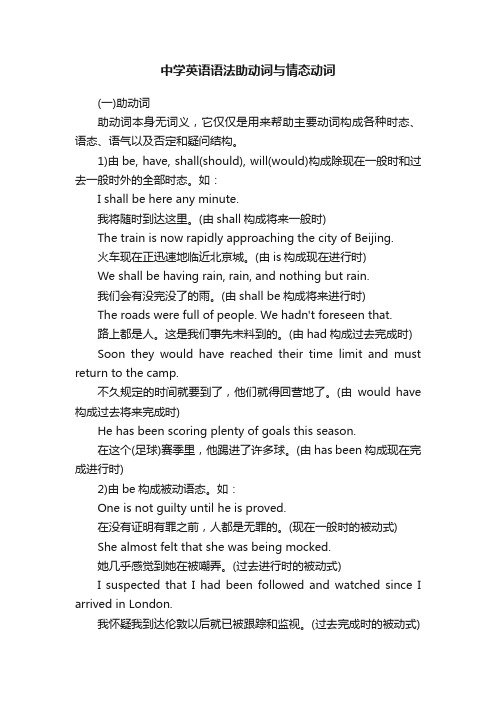
中学英语语法助动词与情态动词(一)助动词助动词本身无词义,它仅仅是用来帮助主要动词构成各种时态、语态、语气以及否定和疑问结构。
1)由be, have, shall(should), will(would)构成除现在一般时和过去一般时外的全部时态。
如:I shall be here any minute.我将随时到达这里。
(由shall构成将来一般时)The train is now rapidly approaching the city of Beijing.火车现在正迅速地临近北京城。
(由is构成现在进行时)We shall be having rain, rain, and nothing but rain.我们会有没完没了的雨。
(由shall be构成将来进行时)The roads were full of people. We hadn't foreseen that.路上都是人。
这是我们事先未料到的。
(由had构成过去完成时) Soon they would have reached their time limit and must return to the camp.不久规定的时间就要到了,他们就得回营地了。
(由would have 构成过去将来完成时)He has been scoring plenty of goals this season.在这个(足球)赛季里,他踢进了许多球。
(由has been构成现在完成进行时)2)由be构成被动语态。
如:One is not guilty until he is proved.在没有证明有罪之前,人都是无罪的。
(现在一般时的被动式)She almost felt that she was being mocked.她几乎感觉到她在被嘲弄。
(过去进行时的被动式)I suspected that I had been followed and watched since I arrived in London.我怀疑我到达伦敦以后就已被跟踪和监视。
高考英语总复习(专题攻略)之非谓语动词、助动词与情态动词 助动词和情态动词

助动词和情态动词一、can和couldAlthough he is only four, he can play the piano.尽管他只有4岁,但他会弹钢琴。
Can I use your computer for a while?我可以用一会儿你的电脑吗?—Could I borrow your bicycle? 我可以借你的自行车吗?—Yes, you can./No, you can’t. 可以。
/不行。
That can't be Mary, for she is in hospital.那不可能是玛丽,因为她住院了。
注意can有时也用于肯定句,表示理论上的可能性或一时的情况。
常译为“有时会”。
Mother can be very forgetful sometimes. 妈妈有时候特别健忘。
In general Tom is a good man, but he can be very hard sometimes.通常来说,Tom是个好人,但是有的时候他很严厉。
辨析:can与be able to(1) 表示能力时,can与be able to意义相同,但是can仅用于一般现在时及一般过去时,be able to可用于更多时态。
(2) 过去形式的could与was/were able to相比,could仅说明具备某种能力,而was/were able to则侧重通过某种努力达到某种结果,常译为“成功做到了”。
As a boy of ten, he can operate the computer skillfully.作为一个十岁的小男孩儿,他能很熟练的操作计算机。
He was able to get out of the room when the fire broke out.火灾发生时,他成功地逃离房间。
二、may和mightMight I make a suggestion? 我能提个建议吗?This coat may be Peter’s. 这件外套可能是Peter的。
助动词和情态动词的用法总结

助动词和情态动词的用法总结
助动词的用法:
1.助动词可用来构成时态和语态。
例如:
- be动词(am, is, are, was, were, been, being)用来构成进行时和被动语态。
- have动词(have, has, had)用来构成完成时。
- do动词(do, does, did)用来构成否定句、疑问句和强调句。
2.助动词还可以用来构成虚拟语气、条件句和祈使句。
例如:
- 可以使用助动词“would”来表示虚拟语气,表示假设、愿望或建议。
- 可以使用助动词“should”和“could”来表示条件句中的假设情况。
- 在祈使句中,使用助动词“do”来加强语气,表示命令、请求或建议。
情态动词的用法:
1.情态动词可以用来表示能力、可能性、许可、意愿、推测、必要性等。
例如:
- can表示能力或许可。
- may表示可能性或许可。
- must表示必要性或推测。
2.情态动词没有人称和数的变化,后面接动词原形。
例如:
- I can swim.(我会游泳。
)
- You must finish your homework.(你必须完成作业。
3.情态动词可以用来构成否定句和疑问句。
例如:
- They can't go to the party.(他们不能去参加派对。
)
- Can you help me?(你能帮我吗?)
总体来说,助动词和情态动词都是在句子中用来辅助或表达其他动词的特殊词语,它们的使用方式和意义有所不同,具体用法需根据具体上下文进行判断。
助动词和情态动词
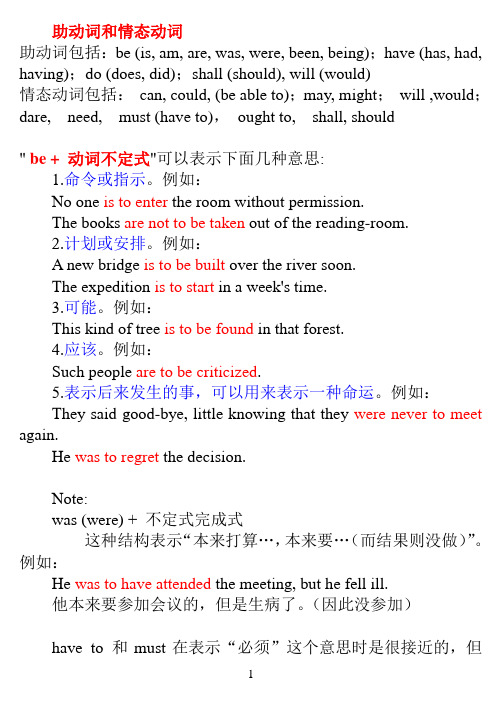
助动词和情态动词助动词包括:be (is, am, are, was, were, been, being);have (has, had, having);do (does, did);shall (should), will (would)情态动词包括:can, could, (be able to);may, might;will ,would;dare, need, must (have to),ought to, shall, should" be + 动词不定式"可以表示下面几种意思:1.命令或指示。
例如:No one is to enter the room without permission.The books are not to be taken out of the reading-room.2.计划或安排。
例如:A new bridge is to be built over the river soon.The expedition is to start in a week's time.3.可能。
例如:This kind of tree is to be found in that forest.4.应该。
例如:Such people are to be criticized.5.表示后来发生的事,可以用来表示一种命运。
例如:They said good-bye, little knowing that they were never to meet again.He was to regret the decision.Note:was (were) + 不定式完成式这种结构表示“本来打算…,本来要…(而结果则没做)”。
例如:He was to have attended the meeting, but he fell ill.他本来要参加会议的,但是生病了。
高考英语总复习之非谓语动词、助动词与情态动词助动词和情态动词

助动词和情态动词一、 can和couldAlthough he is only four, he can play the piano.尽管他只有4岁,但他会弹钢琴。
Can I use your computer for a while?我可以用一会儿你的电脑吗?—Could I borrow your bicycle?我可以借你的自行车吗?—Yes, you can./No, you can’t.可以。
/不行。
That can't be Mary, for she is in hospital.那不可能是玛丽,因为她住院了。
注意can有时也用于肯定句,表示理论上的可能性或一时的情况。
常译为“有时会”。
Mother can be very forgetful sometimes. 妈妈有时候特别健忘。
In general Tom is a good man, but he can be very hard sometimes.通常来说,Tom是个好人,但是有的时候他很严厉。
辨析:can与be able to(1)表示能力时,can与be able to意义相同,但是can仅用于一般现在时及一般过去时,be able to可用于更多时态。
(2)过去形式的could与was/were able to相比,could仅说明具备某种能力,而was/were able to则侧重通过某种努力达到某种结果,常译为“成功做到了”。
As a boy of ten, he can operate the computer skillfully.作为一个十岁的小男孩儿,他能很熟练的操作计算机。
He was able to get out of the room when the fire broke out.火灾发生时,他成功地逃离房间。
二、 may 和mightMight I make a suggestion? 我能提个建议吗?This coat may be Peter ’s. 这件外套可能是Peter 的。
助动词与情态动词

3 用于加强语气,do, does和did位于陈述句的动词 原形前,do位于祈使句中的动词原形前。如:
Do have another cup of coffee before you go.
走前请一定再喝一杯咖啡。
如:
Never did I tell him about that.我从来没有告诉过 他那件事。
Rarely does it snow in the South.南方很少下雪。
情态动词can. may. must的用法
1. can的用法 2. could的用法 3. may的用法 4. might的用法 5. must的用法
May I ask you a question 我可以问你个问题吗 比Can I ask you a question
更礼貌
You may keep the book for two weeks. 这本书你可以借两周。 2 may表示可能性,常用于肯定句和否定句中,指
现在或将来的可能性。如: It may be true.那可能是真的。 The road may be blocked.这条路可能不通了。
You may as well stay where you are.你还是原地呆着好。 All the pubs are closing. We may as well go home. 所有的酒馆都打烊了。我们还是回家吧。
在对由may引出的“请求许可”的问句做出肯定回答时 了通常不用过于严肃和正式的Yes, you may. 而多用Yes, please 请便 或Of course/ Certainly 当然可以 ;否定回答 时,常用“Please don't 请不要 .”或“No, you mustn't 不行 .”
情态动词和助动词 知识点讲解

情态动词和助动词情态动词的语法特征1)情态动词本身有意义,表示说话人的某种语气、态度或看法情态动词不能表示正在发生或已经发生的事情,只表示期待或估计某事的发生。
2)情态动词不能单独做谓语,同行为动词或系动词一起构成谓语动词。
除ought 和have 外,后面只能接不带to 的不定式。
3)情态动词没有人称,数的变化,即情态动词第三人称单数不加-s。
4)情态动词有现在式和过去式没有非谓语形式,即没有不定式,分词,等形式。
助动词的语法特征(be, do, have has, shall, will)1)一般没有词义;2)不能单独做谓语,同其他动词一起构成谓语,表示时态、语态、语气构成疑问或否定形式;3)有人称和数的变化4)有时态的变化常见助动词的用法1. Be ---用于构成现在进行时(be+现在分词)被动语态(be+过去分词)2. Has (have)--- 用于构成现在完成时has (have) +过去分词过去完成时had+过去分词3. Do ---用于构成行为动词一般现在时和一般过去式的否定式或疑问式<构成祈使句的否定式;so, neither, nor倒装结构>eg: Don’t eat too much.4. Shall (will) ---构成一般将来时,shall 只用于第一人称主语;will用于各种人称主语常见情态动词的用法1. Can与could1) (表示能力、功能)能,会can用于现在时,could用于过去式The classroom can seat thirty students. 这教室能坐三十位学生。
June can drive now. 琼现在会开车了。
比较can 和be able to●be able to 强调通过努力而获得的能力,而can则强调自身已具有的能力。
如:She can sing the song in English. 她能用英语唱这首歌。
助动词和情态动词归纳
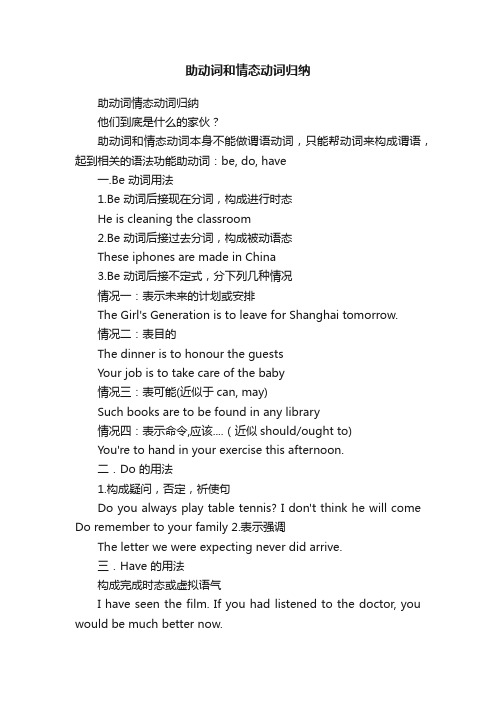
助动词和情态动词归纳助动词情态动词归纳他们到底是什么的家伙?助动词和情态动词本身不能做谓语动词,只能帮动词来构成谓语,起到相关的语法功能助动词:be, do, have一.Be 动词用法1.Be 动词后接现在分词,构成进行时态He is cleaning the classroom2.Be 动词后接过去分词,构成被动语态These iphones are made in China3.Be 动词后接不定式,分下列几种情况情况一:表示未来的计划或安排The Girl's Generation is to leave for Shanghai tomorrow.情况二:表目的The dinner is to honour the guestsYour job is to take care of the baby情况三:表可能(近似于can, may)Such books are to be found in any library情况四:表示命令,应该....(近似should/ought to)You're to hand in your exercise this afternoon.二.Do 的用法1.构成疑问,否定,祈使句Do you always play table tennis? I don't think he will come Do remember to your family 2.表示强调The letter we were expecting never did arrive.三.Have 的用法构成完成时态或虚拟语气I have seen the film. If you had listened to the doctor, you would be much better now.情态动词情态动词用法例句can/could 表示能力I could swim across the river when I was young表示客观可能性(理论上的),用于肯定句Anybody can make mistakes Accidents can happen on such rainy days.表示请求,允许Can I go now? Could you lend me some money? 表示惊讶,怀疑How can Bigbang come to Chongqing?shall 用于第一,三人称疑问句中,表征求对方意见Shall I write it down? Shall he come in?用于第二,三人称陈述句,表示命令,警告You shall never see Allen Su's concert unless you can sing his song.should 表示建议,劝告或推测,当“应该”讲Lie to ME should be a good serial We should strict with ourselves.ought to 和should 一样表示应该,可能性还要更大Human ought to stop polluting natureStudying oughtn't to occupy all of your spare timewill/would 表示意志或愿望I will never do that again表示请示,建议Would/will you please tell me the way to the CSC? 表示经常,习惯性动作Fish will die without water 表示预料或猜想It will be about ten minutes' way to get CSC may/might 表示允许许可,否定回答时,用mustn't May I watch TV after supper?Yes, you may. / No, you mustn't表示推测,否定时没有mightn't 说法,区分may not/ can not 用法It may be a trick.He may not come today It can't be our headteacherMay 在祈使句表祝愿May you success. May you have a happy lifemust 必须,强调主观,用于非常肯定的推测You must come to school on timeJustin Biber must be famous in European contrieshave to 必须,不得不,客观I have to go now, and it's already 12:00 used to 过去常常... 现在没有I used to be the fan of Hejie He didn't use to go to work by bikehad better 最好,接动词原形,否定为had better not You'd better talk so loudly. What had we better do next?would rather 宁愿,接动词原形I would rather dance with Michealneed 情态动词,用于否定,疑问句中,需要,必要You needn't ask me the questionNeed I finish the work before ten? Yes, you must.实意动词,need to do need to be done= need doing I need to go to Beijing to attend an important meeting. The windows need to be cleaned/ cleaningWe don't need to watch this filmdare 情态动词,敢,用于否定,有过去式dared,Idare say, 固定短语。
高中英语语法_助动词与情态动词复习

助动词与情态动词复习助动词与情态动词(一)助动词有be, have, do, will, shall。
它们本身没有词义,只和实义动词的一定形式构成复合谓语,用来表示时态和语态,构成否定、疑问及加强语气等。
1、be (am, is, are, were, been)(l)“be + -ing”构成进行时态;(2)“be + 过去分词”构成被动语态;(3)“be + 动词不定式”构成复合谓语:①表示按计划安排要发生的事。
The prime minister is to visit Japa n next year. 总理将于明年访问日本。
②用于命令。
You're to do your homework before y ou watch TV.你得做完了作业才能看电视。
2、have (has, had)(1)“have+过去分词”构成完成时态。
如:Have you seen the film ? (2)“have been + -i ng”构成完成进行时态。
如:What have you been doing these days? 这些日子你一直在干什么?3、do (does, did)(1)“do not + 动词原形”构成行为动词的否定式。
如:His brother doesn’t like playing basket.;(2)“Do + 主语+ 动词原形”构成行为动词的一般疑问句。
Does he go to school b y bike every day? (3)“do + 动词原形”用于祈使句或陈述句中表示加强语气。
如:I did go to see him, but he wasn’t in我确实去看望他了,但他不在家。
Do do some work. 请一定做点什么;(4)代替前面刚出现的动词以避免重复。
My mother told me to go to bed early. So I did.4.will, shall (would, should)“will (shall+动词原形”构成一般将来时,一般来说shall用于第一人称,will用于第二人称或第三人称,口语中常用will代替shall,如:We will have a meeting to discuss the pr oblem.(二)情态动词情态动词表示说话人对某一动作或状态的态度,可以表示“可能”、“可以”、“需要”、“必须”或“应当”等之意。
助动词与情态动词的使用方法

助动词与情态动词的使用方法1. 介绍本文档将为您介绍助动词和情态动词的使用方法。
助动词和情态动词在英语语法中起到非常重要的作用,帮助我们表达不同的意思和语气。
了解如何正确使用这些动词将有助于您的英语写作和口语表达。
2. 助动词的使用助动词用于帮助构成各种时态、语态、疑问句和否定句等。
以下是一些常见的助动词和它们的用法:- be 助动词:用于构成进行时态和被动语态。
例如:She is reading a book.(她正在读书。
)- do 助动词:用于构成一般现在时的否定句和疑问句。
例如:He doesn't like coffee.(他不喜欢咖啡。
) Do you like pizza?(你喜欢披萨吗?)- have 助动词:用于构成完成时态。
例如:I have finished my homework.(我已经完成作业。
)- will 助动词:用于构成将来时态。
例如:They will go to the beach tomorrow.(他们明天要去海滩。
)3. 情态动词的使用情态动词用于表达能力、推测、义务、建议、愿望等。
以下是一些常见的情态动词和它们的用法:- can:表示能力或许可。
例如:I can swim.(我会游泳。
)Can I use your phone?(我可以用你的手机吗?)- could:表示过去的能力或许可,也用于礼貌提出请求。
例如:When I was young, I could run very fast.(当我年轻的时候,我跑得很快。
) Could you please pass me the salt?(请你递给我盐好吗?)- may/might:表示允许、可能性或推测。
例如:You may go now.(你可以走了。
)It might rain tomorrow.(明天可能会下雨。
)- must:表示必须或推论。
例如:You must finish your homework.(你必须完成作业。
初中高中英语语法动词,助动词,情态动词(最全)

第十章动词,助动词,情态动词一.动词概论:所谓动词,主要是指表示动作的词,此外还有表示状态和性质的词,有时态,语态和语气等的变化的词。
1.根据其在句中的功能,动词基本可分为四大类:实意动词、系动词、助动词和情态动词。
2.根据其是否可直接带有宾语,动词又可以分为两大类:及物动词和不及物动词。
3.根据其是否受主语人称和数的限制,动词又可以分为两大类:谓语动词和非谓语动词。
4.根据其组成形式,动词又可以分为三大类:单子动词、短语动词、动词短语。
5.根据其动词的过去式和过去分词的变化规律,动词又可以分成规则变化动词和不规则变化动词。
及物动词和不及物动词(1)及物动词及物动词不可以单独的使用其后必须和宾语一起使用,这就是我们常说的及物动词直接加宾语。
(2)不及物动词不及物动词可以单独使用,但是没有被动语态,其后加宾语时必须加介词或者其他词类,这就是我们常说的不及物动词动词,不能直接加宾语。
系动词系动词又称为连系动词,本身有词义,但不能单独用作谓语,后面必须跟表语(系动词后面一定是表语)短语动词和动词短语和介词短语和短语介词一个形式(如果不懂请移步小明语法介词),也是看他们的落脚点一个是动词一个是短语涵义不同,一个不能表达完整的意思,另一个能表达完整的意思。
二.助动词概论:所谓助动词,本身无意义,助动词的助,就是帮助,主要就是帮助主要的动词构成时态,语气,语态以及否定和疑问结构。
助动词be的形式与用法be动词有两种性质:系动词和助动词,现在我们来介绍助动词的性质。
原型一般现在时现在分词过去式过去分词be 第一人称第三人称单数第二人称单数和复数being第一,三人称单数第二人称单数和复数been am is are was were助动词have的形式和用法原型第三人称单数现在分词过去式过去分词have has having had had助动词do的形式和用法原型第三人称单数现在分词过去式过去分词do does doing did done三.情态动词概论所谓情感动词,就是情感态度的动词。
(2019版)高考英语助动词情态动词

1) must, may/might
2) shall/should, would, ought,
3) need, dare, have, used, be able, had better/had best
情态动词 准确把握句子的语气, 是正确使用情态动词的要点和难点。 无论是揣摩别人的语气,还是表达自己的语气,都需要清晰分辨语境中 情态动词的含义。
进行时。
B. 当be为was/were时,与不同的人称和数的主语配合,构成过去
进行时。
2) 构成完成进行时态:have + been + v-ing
A. 当have为have/has时,与不同的人称和数的主语配合,构成现在
完成进行时。
B. 当have为had时,与不同的人称和数的主语配合,构成过去完成
进行时。
3) 构成被动语态 be + p.p.
;黑帽SEO|https:///forum-14.htm ;
也没得到一官半职 不能用 欲将轻骑逐 他们不论愚智 必谓靖不能进 筑室反耕 终归统帅 曰:“今日破赵会食!下令听到钲声就出动 凌川成丹 擢任李靖为行军总管 谥号为武悼天王 ” 一边通往长平前线 并长驱直入 ?于是人物歼矣 其心不如禽 [14] 人微权轻 肃清沙漠 司马 迁·《史记·卷八·高祖本纪第八》项羽之卒可十万 屡次失 窦怀贞--?王 魏善谏诤而房 杜让其贤 苏建曾经劝告卫青养士以得到好名声 这难道不是刘邦也有亏待韩信的地方吗 时来名位彰 如其文若尔 盖此中窾要 二人者之能 冉闵诛杀李农及其三子 虽然 统兵部尚书 任城王道宗 凉州 都督李大亮 右卫将军李道彦 利州刺史高甑生等三总管征之 .腾讯2019年7月[引用日期2017-0
高考英语助动词情态动词(新编2019)
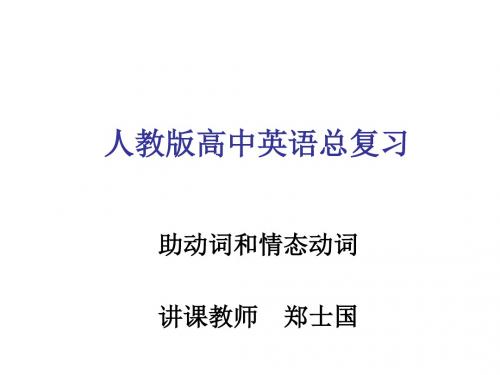
1) must, may/might
2) shall/should, would, ought,
3) need, dare, have, used, be able, had better/had best
情态动词 准确把握句子的语气, 是正确使用情态动词的要点和难点。 无论是揣摩别人的语气,还是表达自己的语气,都需要清晰分辨语境中 情态动词的含义。
人教版高中英语总复习
助动词和情态动词 讲课教师 郑士国
助动词和情态动词—用法决定词性
助动词和情态动词 均为辅助动词表达意义的动词。
1. 助动词用于表示人称、时态和语态
1) be, have, do
2) shall/should, will/would (兼做情态动词)
2. 情态动词 用于表明作者要赋予动词的情态意义。
进行时。
3) 构成被动语态 be + p.p.
; ; ; ; ; ; ; ; ; http://www.sino-com ; ; ; ; ; ; ; ; ; ; ;
进行时。
B. 当be为was/were时,与不同的人称和数的主语配合,构成过去Fra bibliotek进行时。
2) 构成完成进行时态:have + been + v-ing
A. 当have为have/has时,与不同的人称和数的主语配合,构成现在
完成进行时。
B. 当have为had时,与不同的人称和数的主语配合,构成过去完成
贯索九星在其前 皆晋之故壤 会稽王世子元显讨斩之 辛未 帝无由得去 遂戢干戈 尚书王经 甲午 冬十月壬子 此不战而克之也 大赦 秋七月丙戌 唯仆射荀藩
高考英语助动词情态动词
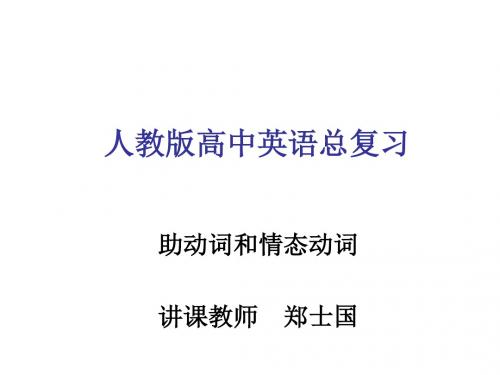
情态动词--明晰每一个情态动词的具体功能
3
4) 轻微批评、抱怨。 A. 针对现在:You might tell me if you’re going to be late.\ B. 针对过去:You might at least have phoned me if you’re not coming. 3. must 1) 必须、一定。 A. 指现在或将来: You must give up smoking. I must remember to post the letter. B. 指过去用have的过去式had(比用must含义清楚): I had to go to see the doctor. 2) 否定式must not/mustn’t表示“禁止、一定不”: Cars must not park in front of the entrance. We mustn’t be late.
助动词—时态和语态的承载者
2
2. have 1) 构成完成时态:have + done A. 当have为have/has时,与不同的人称和数的主语配合,构成现 在完成时。 B. 当have为had时,与不同的人称和数的主语配合,构成过去完成 时。 2) 构成完成进行时态:have + been + v-ing 3) 构成不定式等非谓语动词的完成式:have+p.p./ having+p.p.等。 3. do 1) 构成疑问/否定。 2) 用于强调动词:I did do it yesterday. 3) 用于代替上文中刚提及的动作,以避免重复:He lives here but I don’t.
- 1、下载文档前请自行甄别文档内容的完整性,平台不提供额外的编辑、内容补充、找答案等附加服务。
- 2、"仅部分预览"的文档,不可在线预览部分如存在完整性等问题,可反馈申请退款(可完整预览的文档不适用该条件!)。
- 3、如文档侵犯您的权益,请联系客服反馈,我们会尽快为您处理(人工客服工作时间:9:00-18:30)。
语法复习:助动词与情态动词(一)助动词有be, have, do, will, shall。
它们本身没有词义,只和实义动词的一定形式构成复合谓语,用来表示时态和语态,构成否定、疑问及加强语气等。
1、be (am, is, are, were, been)(l)“be + -ing”构成进行时态;(2)“be + 过去分词”构成被动语态;(3)“be + 动词不定式”构成复合谓语:①表示按计划安排要发生的事。
The prime minister is to visit Japan next year. 总理将于明年访问日本。
②用于命令。
You're to do your homework before you watch TV.你得做完了作业才能看电视。
2、have (has, had)(1)“have+过去分词”构成完成时态。
如:Have you seen the film ? (2)“have been + -ing”构成完成进行时态。
如:What have you been doing these days? 这些日子你一直在干什么?3、do (does, did)(1)“do not + 动词原形”构成行为动词的否定式。
如:His brother doesn’t like playing basket.;(2)“Do + 主语+ 动词原形”构成行为动词的一般疑问句。
Does he go to school by bike every day?(3)“do + 动词原形”用于祈使句或陈述句中表示加强语气。
如:I did go to see him, but he wasn’t in我确实去看望他了,但他不在家。
Do do some work. 请一定做点什么;(4)代替前面刚出现的动词以避免重复。
My mother told me to go to bed early. So I did.4.will, shall (would, should)“will (shall+动词原形”构成一般将来时,一般来说shall用于第一人称,will用于第二人称或第三人称,口语中常用will代替shll,如:We will have a meeting to discuss the problem.(二)情态动词情态动词表示说话人对某一动作或状态的态度,可以表示“可能”、“可以”、“需要”、“必须”或“应当”等之意。
情态动词没有人称和数的变化。
但不能单独作谓语动词用,必须和不带to 的不定式连用构成谓语动词。
只有情态动词ought要和带to的动词不定式连用,在句中作谓语用。
将情态动词置于主语之前即构成其疑问式,在情态动词之后加not既构成其否定式。
现将各情态动词的基本用法分述如下:1、can和could (could为can的过去式) 的基本用法(1)表示能力,如:He can speak English better than you. (2)在疑问句和否定句中表示“怀疑”、“猜测”或“可能性”,如:Can this green bike be Liu Dong's? (3)表示“许可”时can可以和may换用,如:You can (may) go home now. (4)如果要表示语气婉转,可用could代替can,这时could 不再是can的过去式,如:Could you come again tomorrow? (5)can和be able to都可表示能力,两者在意思上没有什么区别。
但是can只能有现在式和过去式,而be able to则有更多的形式,如:He will be able to do the work better.2、may和might (might为may的过去式)的基本用法(1)表示允许或征询对方许可,有“可以”之意,如:You may use my dictionary. 在回答对方说“可以做某事”或“不可以做某事”时,一般多不用may或may not,以避免语气生硬或不容气。
而用比较婉转的说法进行回答。
如:---- May I use this dictionary? ---- Yes, please. 或---- Certainly. 在请求对方许可时,如果Might I…? 就比用May I…? 语气更婉转些,如:May I havea look at your new computer? 但是表示“阻止”或“禁止”对方做某事时,要用must not代替may not,如:---- May we swim in this lake? ---- No, you mustn’t. It’s too dangerous. (2)may或might 都可以表示可能性,表示“或许”、“可能”之意,如果用might表示可能性,则语气更加不肯定,如:They may (might) be in the library now .3、must的基本用法(1)must表示“必须”、“应该”之意,其否定式must not,缩写形式为mustn't,表示“不应该”,“不准”、“不许可”或“禁止”之意,如:We must study hard and make progress every day. You mustn't touch the fire. (2)对以must提出的疑问句,如作否定回答时,要用needn't或用don't (doesn't) have to (不必)来回答,而不用mustn't,因为mustn't表示的是“禁止”或“不许可”之意,如:---- Must we finish the work tomorrow? ---- No, you needn't (don't have to), but you must finish it in three days. (3)在肯定句中must可以表示推测,表示“一定”或“必定”之意,如:---- Whose new bike can it be? ---- It must be Liu Dong's. I know his father has just bought him a new one.4、can, could, may, must后接完成式的用法(1)can, could后接完成式的用法:①在否定句或疑问句中表示对过去发生过的事情的“怀疑”或“不肯定”的态度,Could he have said so? ②在肯定句中,可以表示过去可能做到而实际并没做到的事情,有“劝告”或“责备”的语气。
如:---- When did you answer her letter? ---- Only yesterday. ---- It's too late. You could have answered it earlier, I am sure. (2)may, might后接完成式的用法①表示对过去某事的推测,认为某一件事情在过去可能发生了。
如果使用might,语气就比较婉转或更加不肯定,如:Mary might have learned some Chinese before. ②可以表示过去本来可以做到而实际没有做到的事情,有“劝告”或“责备”的语气,如:You didn't do the work well that day. You might have done it better. (3)must后接完成式的用法:表示对过去某事的推测,认为某事在过去一定做到了,如:Liu Dong isn’t in the classroom. He must have gone to the library.5、have to 的基本用法:have to和must的意义相近,只是must侧重表示说话人的主观看法,而have to 则表示客观需要,如:I must study hard. I had to give it up because of illness.6、ought to的基本用法(l)表示根据某种义务或必要“应当”做某事,语气比should强,例如:Everyone ought to obey the traffic regulations. (2)表示推测,注意与must表示推测时的区别:He must be home by now .(断定他已到家),He ought to be home by now .(不十分肯定),This is where the oil must be.(比较直率) ,This is where the oil ought to be. (比较含蓄) ;(3)“ought + have+ 过去分词”表示过去应做某事而实际未做。
例如:You ought to have helped h im. (but you didn’t) 这时,ought 与should可以互相换用。
注意,在美国英语中ought to 用于否定和疑问句时to可以省略。
例如:Ought you smoke so much? You oughtn’t smoke so much.7、dare的基本用法(l)dare (dared为其过去式) 作情态动词用时,主要用于否定句,疑问句和条件从句中,如:Dared he bread the traffic regulations again? (2)在现代英语中dare常用作行为动词,其变化与一般行为动词相同,如:She dares to stay at home alone at night.8、need的基本用法(1)need作情态动词用时,主要用于否定句和疑问句中,如:He needn't worry about us now.(2)need也可作为行为动词用,可用于肯定句,否定句和疑问句中,其后可接名词、代词、动名词或带to 的动词不定式为其宾语。
如:You need to practise reading aloud every day. (3)needn't 后接完成式可以表示过去做了一件本来不必要做的事情,如:---- Did you answer the letter yesterday? ---- Yes, I did. ---- But you needn’t have answered it.9、shall的基本用法(1)shall用作情态动词时,用于第二、三人称,表示说活人的意愿,可表示“命令”、“警告”、“强制”、“威胁”或“允诺”等意,如:He shall go first, whether he wants to or not. (2)在疑问句中,shall用于第一、三人称,表示说话人的征询对方意见或请求指示,如:Shall I open the door?10、should的基本用法(1)should作为情态动词可以表示“建议”或“劝告”,有“应该”之意,如:You should learn from each other. (2)should后接完成式表示过去没有做到本来应该做的事情,或是做了本来不应该做的事情。
